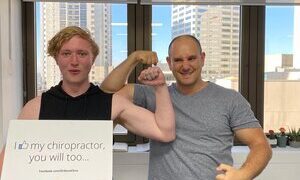Back pain shouldn’t control your life. Yet many people struggle to find relief, even though chiropractic adjustments rank as Australia’s most sought-after natural treatment option. The reason? Patients who choose chiropractic care cut their painkiller use in half compared to those who don’t.
Your body deserves care that fits your unique needs. We see it in our practice every day – patients wondering which adjustment technique will work best for them. With 11% of people worldwide facing spine-related pain, this confusion is more common than you might think.
Good news – choosing the right adjustment technique doesn’t have to feel overwhelming. Whether nagging back pain keeps you up at night, or you’re seeking better sleep (a benefit one-third of our patients report), this guide walks you through picking the perfect approach for your body.
Ready to feel confident about your chiropractic care? Let’s discover the adjustment technique that will have you moving and feeling better. Your path to natural pain relief starts here.
Understanding Your Body’s Unique Needs
“Look Well to the SPINE for the cause of disease.” — Hippocrates, Father of Modern Medicine
Your spine tells a story only you can share. Like fingerprints, each person’s body responds differently to chiropractic care. Smart chiropractors recognise these differences and create personalized treatment plans that match your specific needs.
Identifying your specific discomfort areas
Your first chiropractic visit starts with detective work. Your chiropractor’s trained hands feel for subtle clues in your muscles and joints – a process called palpation. This gentle examination reveals areas of tension, restricted movement, and structural changes that need attention.
Watch as your chiropractor observes your posture and checks how well you can move. They’ll measure how far you can bend, twist, and turn. These simple tests speak volumes about your body’s condition. Limited movement often points to specific problems:
- Tight joint capsules
- Muscle tension
- Misaligned bones
These careful checks matter more than you might think. After all, muscle and joint problems affect up to one-third of older adults, limiting their daily activities.
How your daily activities affect treatment choices
Your daily routine shapes your body’s needs. Simple things like sitting at your desk or checking your phone create patterns in your muscles and joints. Your chiropractor looks for signs of stress from:
- Long hours at your desk
- Repeated work movements
- Exercise habits
- Sleep positions
- Screen time
These everyday habits leave their mark on your body. Understanding these patterns helps your chiropractor choose techniques that work best for your lifestyle. An office worker’s treatment might look very different from an athlete’s, even if their pain feels similar.
The importance of your health history
Your health story guides your care plan. Past injuries, surgeries, and ongoing health issues paint a picture of your body’s journey. Even old injuries can create new problems as your body adapts over time.
During your first visit, expect questions about:
- When your pain started
- What makes it better or worse
- Treatments you’ve already tried
- Other health concerns
“Patient history prevents false starts in the treatment plan,” research shows. This careful approach might seem detailed, but it ensures your treatment targets the real cause of your discomfort, not just the symptoms.
Think of your first visit as laying the foundation for lasting relief. Your chiropractor’s thorough approach means better care designed specifically for your body’s needs.
Common Chiropractic Adjustment Techniques
Picture a toolbox filled with precise instruments. Just like a skilled craftsman, chiropractors select specific tools and techniques to address your unique needs. While over 200 adjustment methods exist, a handful of core techniques help most patients find relief. Let’s explore these proven approaches to help you make informed choices about your chiropractic adjustment benefits.
Manual adjustments: What to expect
Think of manual adjustments as the classic approach to chiropractic care. Nearly 96% of chiropractors use the Diversified Technique, making it the foundation of modern practice. Your chiropractor’s trained hands deliver precise, gentle thrusts to free restricted joints.
Here’s what happens during a manual adjustment:
- You’ll rest comfortably on a specially designed table
- Your chiropractor positions their hands with careful precision
- A quick, specific movement releases joint restriction
- Many patients notice immediate improvement in movement
That familiar “pop” you might hear? It’s simply gas bubbles releasing from joint fluid. While the sound surprises some patients, it’s perfectly normal – like opening a bottle of sparkling water. These hands-on adjustments restore proper joint movement and ease pain by correcting spinal alignment.
Instrument-assisted methods for gentler treatment
Some patients prefer a lighter touch. Enter the Activator Method – a gentle approach used by 62.8% of chiropractors. This handheld tool delivers quick, precise taps that work faster than your muscles can tense up.
“The instrument is so quick that the body’s muscles are less likely to tense in response, and resist the treatment,” research confirms. Perfect for seniors, acute pain sufferers, or anyone nervous about traditional adjustments, these tools work without twisting or turning your joints.
Table-assisted techniques and their benefits
Special chiropractic tables add another dimension to gentle care. The Thompson Drop-Table technique, chosen by 55.9% of chiropractors, uses cleverly designed segments that “drop” slightly during adjustment.
One chiropractor describes it perfectly: “The gentle dropping motion is comfortable for patients, resembling a light vibration”. This approach helps patients with back pain, neck pain, and shoulder problems find relief without forceful movements.
Cox Flexion-Distraction offers another table-based solution, trusted by 58% of chiropractors. The table gently stretches and flexes your spine in controlled ways. Research shows this gentle method effectively treats herniated disks, sciatica, and spinal stenosis – all without aggressive manipulation.
Specialised approaches for specific conditions
Some problems need specific solutions. The Gonstead technique, practiced by 58.5% of chiropractors, uses careful analysis – often including X-rays – to pinpoint exact problem areas. Whether you’re sitting or lying on your side, these precise adjustments target lower back and pelvic issues with remarkable accuracy.
Struggling with neck pain or dizziness? Studies show instrument-assisted techniques bring particular relief to older adults. For lower back issues, the Sacro-Occipital Technique (SOT) – used by 41.3% of chiropractors – employs special wedge-shaped blocks under your pelvis to restore balance between your tailbone and skull base.
Your chiropractor will match the right technique to your needs, comfort level, and health goals. Understanding these options helps you take an active role in your care journey and get the most from your benefits of getting a chiropractic adjustment.
Matching Techniques to Your Comfort Level
Your comfort matters more than you might think. Patients who feel at ease with their treatment style heal better and stick with their care plans longer. Let’s help you find an approach that feels right for you.
Assessing your comfort with different approaches
Close your eyes for a moment. Picture yourself getting an adjustment. Does the thought of hearing that familiar “pop” make you tense up? Or do you find the sound reassuring? Your honest reaction guides us toward the right technique for you.
Take a moment to consider:
- Past experiences with hands-on therapy
- How you feel about different treatment positions
- Areas of your body that need extra gentle care
- Your overall comfort with physical treatments
Smart patients chat with their chiropractor before starting treatment. This first conversation lets you learn about their approach and share any worries. A good chiropractor listens carefully to your concerns and explains everything clearly.
Remember – you’re in charge of your care journey. As experts note, “The chiropractor’s role is to recommend the course of care for the patient, and it is the patient’s decision whether or not to accept that doctor’s recommendations”.
Options for those who prefer gentler methods
Not everyone enjoys traditional adjustments. Good news – gentle techniques work just as well without any twisting or forceful movements.
The Activator Method feels like “gently but quickly pushing your thumb into the palm of your hand”. This small tool delivers precise, controlled taps perfect for sensitive areas.
Picture lying comfortably on your back while your chiropractor guides your neck through gentle figure-8 movements. That’s cervical mobilisation – a smooth, stretching technique that slowly increases your range of motion without sudden changes.
Some patients love the Thompson Drop-Table method. Special table sections lower slightly during treatment, using gravity to do the work. No twisting required – just gentle, effective adjustments.
Your perfect technique matches both your body’s needs and your comfort level. Open conversation with your chiropractor ensures treatment feels right from day one.
The Benefits of Choosing the Right Adjustment
“I have to have an adjustment before I go into the ring. I do believe in chiropractic. I found that going to a chiropractor three times a week helps my performance. The majority of boxers go to get that edge.” — Evander Holyfield, Heavyweight Champion Boxer
Picture waking up without that familiar morning stiffness. Imagine moving freely through your day without pain holding you back. The right chiropractic technique makes these dreams real. Let’s explore how proper adjustments create lasting changes in your body.
Improved mobility and function
Your body craves freedom of movement. Studies show the right spinal adjustment delivers exactly that, helping you move better and feel stronger. Here’s how proper adjustments help:
- Free pinched nerves through better joint alignment
- Release tight muscles that limit your movement
- Wake up sleeping nerve pathways
- Restore natural range of motion
Numbers tell the story – patients receiving proper chiropractic care move 9.2% faster, while those without care improve only 1.7%. Think about that difference as you reach for your morning coffee or play with your kids.
Better sleep and reduced tension
Sleep changes everything. One in three patients sleep better right after their first adjustment. Makes sense, right? When your body hurts, sleep suffers. When sleep suffers, pain feels worse.
The right adjustment breaks this cycle. Your muscles relax. Your mind calms down. Stress melts away as your body finds its natural balance. Better yet, adjustments help reset your body’s sleep-wake rhythm, making good rest more natural.
Supporting your body’s natural healing process
Your body knows how to heal – sometimes it just needs a helping hand. Think of proper spinal alignment like clearing a blocked road. When we remove interference, healing flows naturally.
Good adjustments boost three vital flows in your body – nerve signals, lymph fluid, and blood. This means every cell gets what it needs and removes what it doesn’t.
Smart adjustment choices do more than mask pain – they create the perfect environment for real healing. Your body takes care of the rest, working as nature intended.
Communicating Effectively With Your Chiropractor
Think of your chiropractor as your wellness partner. Clear, honest talks lead to better results. Your input shapes treatment success just as much as the adjustment techniques themselves.
Questions to ask during your consultation
Smart questions open doors to better care. Your first visit sets the tone for your entire healing journey. Come prepared with questions that matter to you.
Try these proven conversation starters:
- “Why does this treatment approach fit my specific condition?”
- “Could you explain potential risks or side effects?”
- “What research supports this treatment’s success?”
- “How many visits might I need, and how will we track progress?”
- “Should my regular doctor know about this treatment plan?”
Remember to share your full health story. Tell your chiropractor about bone or joint conditions, blood-thinning medications, or skin concerns. These details matter more than you might think.
How to describe your experience after adjustments
Your body speaks after every adjustment. Listen carefully and share what you hear. Skip vague words like “fine” or “okay” – paint a clear picture instead.
Notice changes right away? Tell your chiropractor. Feel different a few days later? Share that too. Even small shifts matter, whether they seem connected to your main problem or not.
Talk about your discomfort like a weather report – how strong, how long, how different from usual. These details help your chiropractor fine-tune your care for better results.
Creating a collaborative treatment approach
The best healing happens through teamwork. You bring valuable insights about your body, while your chiropractor brings clinical expertise.
Trust grows from honest talks and proven skills. Research shows that chiropractors who communicate clearly and show real expertise create stronger bonds with their patients.
Speak up about your goals. Share your worries about specific techniques. Help set realistic timelines for your recovery. This team approach ensures your treatment fits both your body’s needs and your comfort zone.
Conclusion
Your path to better health starts with choosing the right adjustment technique. Like finding the perfect key for a lock, skilled chiropractors match specific methods to your body’s unique patterns and daily routines.
Trust your comfort instincts. Some patients love traditional hands-on adjustments, while others prefer gentler approaches. Both paths lead to healing – research shows feeling at ease with your treatment choice brings better results and keeps you committed to care longer.
Picture chiropractic care as a dance between you and your practitioner. Your steps matter just as much as theirs. Speaking openly about what you feel, what concerns you, and what you hope to achieve creates the perfect rhythm for healing.
Ready to discover which adjustment technique fits you best? Book a full spinal check today. Your body’s natural healing power awaits – properly chosen adjustments simply remove the roadblocks standing in its way.
FAQs
Q1. How do I know if a chiropractor is right for me? A good chiropractor will conduct a thorough assessment of your health, provide a clear treatment strategy, and be sensitive to your pain and needs. They should also be willing to have a short phone conversation to discuss their practice preferences and overall approach before your first appointment.
Q2. What are the most effective chiropractic techniques? While effectiveness can vary depending on individual needs, some widely recognized techniques include the Diversified Technique, Gonstead Method, and Activator Method. The most suitable technique for you will depend on your specific condition, comfort level, and health goals.
Q3. Are there any warning signs I should look out for when choosing a chiropractor? Be cautious of chiropractors who start adjusting without discussing your condition first or who use scare tactics to pressure you into long-term treatment plans. A reputable chiropractor will always explain their approach and address your concerns before beginning treatment.
Q4. How can I communicate effectively with my chiropractor? Prepare specific questions about your treatment plan, potential risks, and expected outcomes. After adjustments, provide detailed feedback about any changes in your comfort level or range of motion. Open and honest communication helps create a collaborative approach to your care.
Q5. What benefits can I expect from choosing the right chiropractic adjustment? Selecting the appropriate chiropractic technique can lead to improved mobility and function, better sleep, reduced tension, and enhanced overall well-being. The right adjustment supports your body’s natural healing process by addressing underlying issues rather than just treating symptoms.





![Why Your Sydney Chiropractor for Back Pain Might Be Your Best Choice [Improved Guide]](https://www.mychiro.com.au/wp-content/uploads/2023/05/MyChiro_008-360x180.webp)